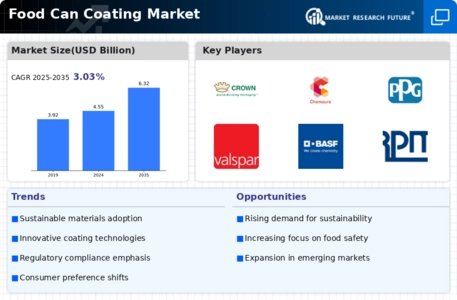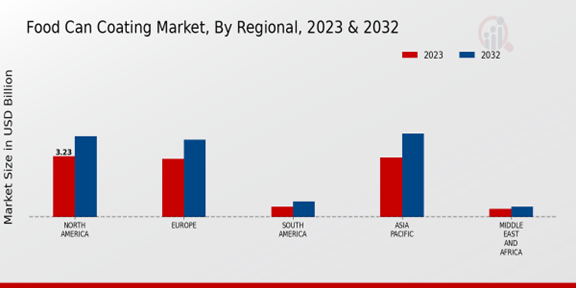Market Growth Projections
The Global Food Can Coating Market Industry is projected to experience substantial growth over the coming years. With a market value of 4.55 USD Billion in 2024, it is expected to reach 6.32 USD Billion by 2035. This growth trajectory indicates a compound annual growth rate of 3.03% from 2025 to 2035. Various factors, including rising demand for sustainable packaging, technological advancements, and changing consumer preferences, are likely to contribute to this upward trend. The market's expansion reflects the increasing importance of food safety, convenience, and environmental considerations in packaging solutions.
Growth of the Processed Food Sector
The Global Food Can Coating Market Industry is closely linked to the expansion of the processed food sector. As urbanization continues to rise, there is an increasing demand for convenient food options, which often come in canned forms. This trend is particularly evident in developing regions where busy lifestyles drive the consumption of ready-to-eat meals. The processed food sector's growth is expected to bolster the demand for food can coatings, as manufacturers seek to enhance product safety and shelf life. This rising demand for convenience foods is anticipated to contribute positively to the overall market dynamics.
Rising Demand for Sustainable Packaging
The Global Food Can Coating Market Industry is witnessing a marked increase in demand for sustainable packaging solutions. Consumers and manufacturers alike are increasingly prioritizing eco-friendly materials, which has led to a shift towards coatings that are recyclable and biodegradable. This trend is driven by heightened environmental awareness and regulatory pressures aimed at reducing plastic waste. As a result, the market is projected to grow from 4.55 USD Billion in 2024 to 6.32 USD Billion by 2035, reflecting a compound annual growth rate of 3.03% from 2025 to 2035. Companies are innovating to meet these demands, thereby enhancing their market positions.
Consumer Preferences for Healthier Food Options
The Global Food Can Coating Market Industry is experiencing a shift in consumer preferences towards healthier food options. As awareness of nutrition and health issues increases, consumers are more inclined to choose products that are perceived as healthier, including those packaged in cans. This trend is prompting manufacturers to reformulate their products and invest in coatings that do not leach harmful substances into food. The emphasis on health and wellness is likely to drive the demand for safe and effective food can coatings, as companies strive to align their offerings with consumer expectations.
Regulatory Compliance and Food Safety Standards
Regulatory compliance plays a crucial role in shaping the Global Food Can Coating Market Industry. Governments worldwide are implementing stringent food safety standards that necessitate the use of safe and compliant coatings for food packaging. These regulations aim to protect consumer health and ensure that food products remain uncontaminated during storage and transportation. As a result, manufacturers are compelled to invest in high-quality coatings that meet these standards, thereby driving market growth. Compliance with these regulations not only enhances consumer trust but also opens up new market opportunities for innovative coating solutions.
Technological Advancements in Coating Applications
Technological advancements are significantly influencing the Global Food Can Coating Market Industry. Innovations in coating technologies, such as the development of high-performance coatings that enhance durability and resistance to corrosion, are becoming increasingly prevalent. These advancements not only improve the shelf life of canned food but also ensure that the coatings are safe for food contact. As manufacturers adopt these technologies, they are likely to gain a competitive edge, thereby driving market growth. The integration of smart coatings that can indicate spoilage or contamination may further revolutionize the industry, appealing to health-conscious consumers.












